Citroen C6 RHD 2011 1.G Owner's Manual
Manufacturer: CITROEN, Model Year: 2011, Model line: C6 RHD, Model: Citroen C6 RHD 2011 1.GPages: 216, PDF Size: 10.19 MB
Page 101 of 216

99
III
A
BC
D
REAR SEATS
Seat cushion folded.
Stow the head restraints.
Pr
ess the controlA located at theend of the backrest and fully tilt for-
wards.
The benchseat backrest can befolded in two sections. When youreposition the backrest, make sure
that it locks in place.Your vehicle's boot can be kept
isolated from the passen
ger com-
partment.
T
o lock the access to the boot:1.Place the benchseat in its correct position.The red warning lamp oncontrol Ashould no longer be
visible.
2.Insert the ignition key in thelock.3. Lock it.
Before moving the seats
So as to avoid damaging the seat belts by jamming them, takecare to keep them to the sides of the backrest.
LOCKING/UNLOCKING OF THE ACCESS INTO THE BOOT VIA THE REAR BENCHSEATREAR CENTRAL SEAT BELT
For easier opening of the seat beltcover D, you should fi rst raise thecentral head restraint.
Insert the fi rst fasteningC into thefront left hand (black) buckle, then
insert the second fastening B intothe front right hand buckle.
Page 102 of 216

100
III
B
A
PACK LOUNGE SEATS
ANGLE OF THE REAR LATERAL HEADRESTRAINTS
To alter the angle of the rear lateralhead restraints, lift them then tilt
them upwards.
LONGITUDINAL
ADJUSTMENT OF THE
FRONT PASSENGER'S
SEA
T
For more room for the rear passen-ger, it is possible for the front pas-senger's seat to beslid forwardfrom the rear seat position.
To slide the front passenger's seatforward, press on the control Bat
the centre of the armrest.
Note: This control Bis not active if
adjustments are being made simul-
taneously at the front.
The front passen
ger's seat will slideforward for as long as you keepcontrolBpressed. It stops immedi-
ately you release controlB.
Note: Use of the child safety deac-
tivates button B. See "Windows".
ADJUSTING THE SEAT AND
ITS BACKREST
You can adjust the longitudinal position of the seat and theangleof its backrest simultaneously using the controlA.
IMPORTANT
Pack Loungeseats cannot be folded.
Note: Use of the child safety deac-
tivates buttonA. See "Windows".
Page 103 of 216
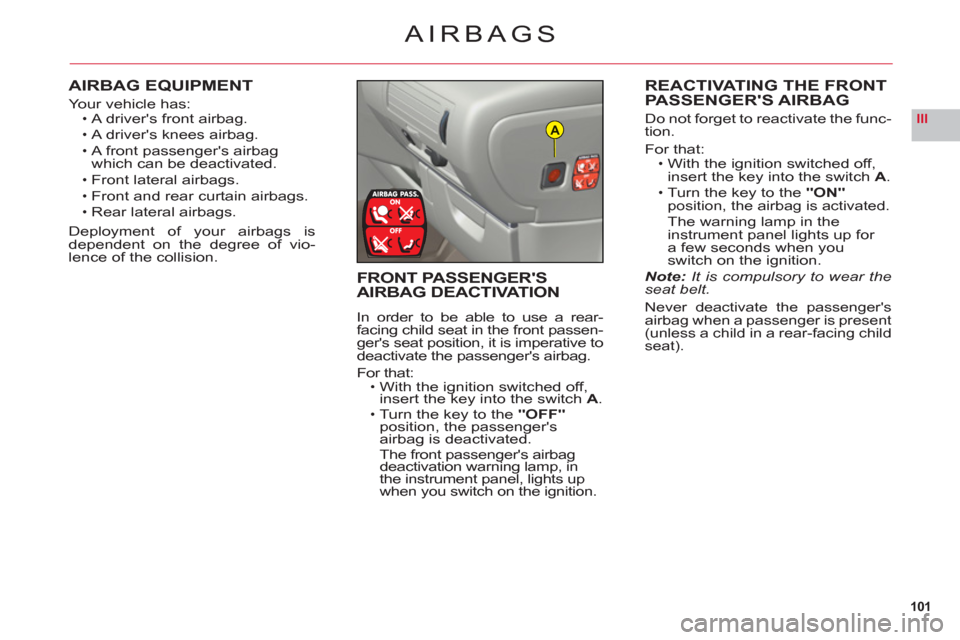
101
IIIA
AIRBAGS
AIRBAG EQUIPMENT
Yo ur vehicle has:A driver's front airbag.
A driver's knees airbag.
A front passenger's airbag
which can be deactivated.
Front lateral airba
gs.
Front and rear curtain airbags.
Rear lateral airbags.
Deplo
yment of your airbags is
dependent on the degree of vio-lence of the collision.
•
•
•
••
•
REACTIVATING THE FRONTPASSENGER'S AIRBAG
Do not forget to reactivate the func-
tion.
For that:With the ignition switched off, insert the key into the switch A.Turn the key to the"ON"position, the airbag is activated.
The warning lamp in the
instrument panel lights up for
a few seconds when youswitch on the ignition.Note: It is compulsory to wear theseat belt.
Never deactivate the passenger'sairbag when a passenger is present(unless a child in a rear-facing child
seat).
•
•
FRONT PASSENGER'SAIRBAG DEACTIVATION
In order to be able to use a rear-facing child seat in the front passen-ger's seat position, it is imperative to
deactivate the passenger's airbag.
For that:With the ignition switched off,
insert the key into the switchA.Turn the key to the "OFF"
position, the passenger's airbag is deactivated.The front passenger's airbag deactivation warning lamp, in
the instrument panel, lights up
when you switch on the ignition.
•
•
Page 104 of 216
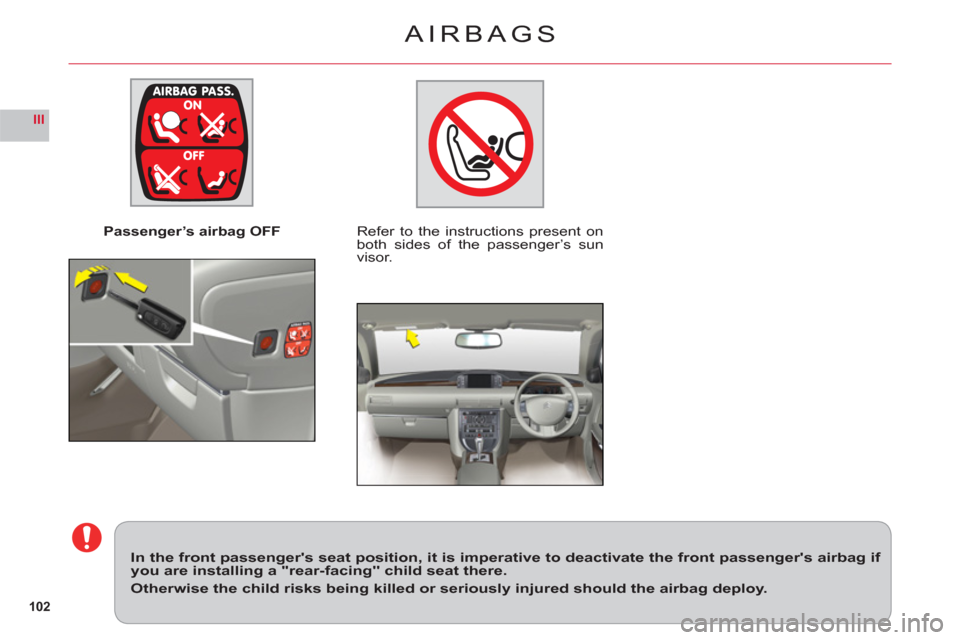
102
III
Passenger’s airbag OFFRefer to the instructions present on
both sides of the passenger’s sun
visor.
In the front passenger's seat position, it is imperative to deactivate the front passenger's airbag if you are installing a "rear-facing" child seat there.
Otherwise the child risks being killed or seriously injured should the airbag deploy.
AIRBAGS
Page 105 of 216
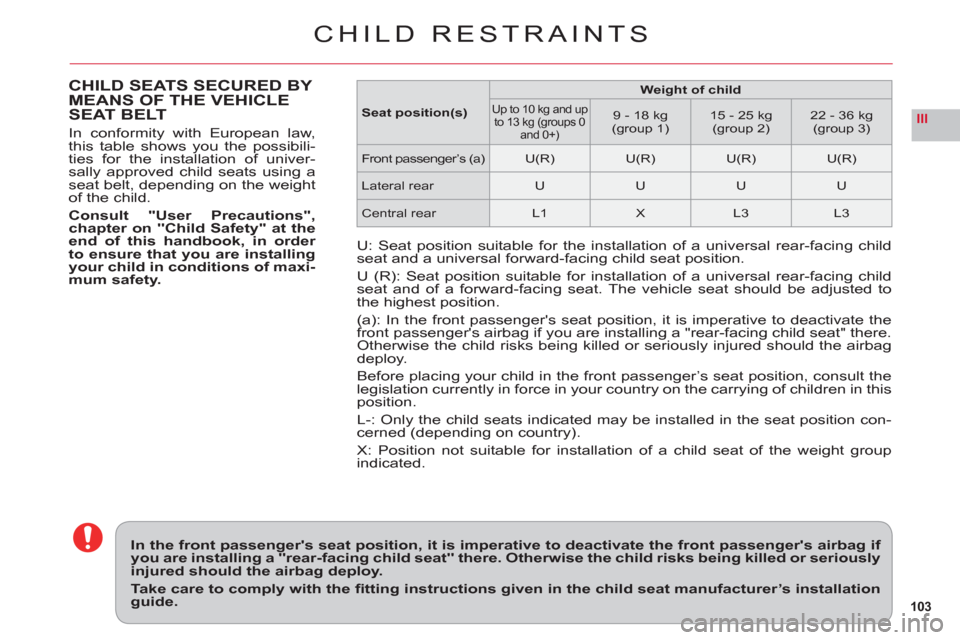
103
III
CHILD RESTRAINTS
CHILD SEATS SECURED BY MEANS OF THE VEHICLE
SEAT BELT
In conformity with European law,
this table shows you the possibili-
ties for the installation of univer-sally approved child seats using aseat belt, depending on the weightof the child.
Consult "User Precautions",chapter on "Child Safety" at theend of this handbook, in order
to ensure that you are installingyour child in conditions of maxi-mum safety.
Seat position(s)
Weight of child
Up to 10 kg and upto 13 kg (groups 0 and 0+)
9 - 18 kg (group 1)15 - 25 kg(group 2)22 - 36 kg(group 3)
Front passenger’s (a)U(R)U(R)U(R)U(R)
Lateral rearUUUU
Central rearL1XL3L3
In the front passenger's seat position, it is imperative to deactivate the front passenger's airbag if you are installing a "rear-facing child seat" there. Otherwise the child risks being killed or seriously injured should the airbag deploy.
Take care to comply with the fi tting instructions given in the child seat manufacturer’s installation guide.
U: Seat position suitable for the installation of a universal rear-facing child
seat and a universal forward-facing child seat position.
U (R): Seat position suitable for installation of a universal rear-facing child
seat and of a forward-facing seat. The vehicle seat should be adjusted to
the highest position.
(a): In the front passenger's seat position, it is imperative to deactivate the
front passenger's airbag if you are installing a "rear-facing child seat" there.Otherwise the child risks being killed or seriously injured should the airbagdeploy.
Before placin
g your child in the front passenger’s seat position, consult thelegislation currently in force in your country on the carrying of children in this
position.
L-:
Only the child seats indicated may be installed in the seat position con-cerned (depending on country).
X: Position not suitable for installation of a child seat of the weight groupindicated.
Page 106 of 216

104
III
ab
ab
Pack Lounge seats
ISOFIX ANCHORINGPOINTS AND THE ISOFIX
FASTENING SYSTEM
Your vehicle is type-approvedaccording to new ISOFIX direc-
tives. The lateral rear seats of your vehicle are each equipped
with regulation ISOFIX anchoringpoints.
In
correct installation of a childseat in a vehicle compromisesprotection of the child in the event
of a collision. The ISOFIX systemenables you to minimise the risksposed by incorrect fi tting. The
ISOFIX fastening system givesyou a convenient, strong andreliable fi tting for a child seat inyour vehicle.
Benchseat
The ISOFIX fastening system
The ISOFIX system features3ringsfor each lateral rear seat position:Two bottom rings a andblocated between the backrestand the seat cushion. These areabout 28 cm apart,concealed
in the case of a benchseat under
a fl ap with the logo ISOFIX.
One top ring c fi xed on the rear shelf,concealedunder a fl apwith the logo
TOP TETHERbehind the head restraint.
•
•
The ISOFIX child seat fasteningsystem
ISOFIX child seats have twolatches which are easy to secure
on the two bottom rings aandb.
Some ISOFIX child seats also have
a top belt which is for attaching on
the ISOFIX top ringc.
To attach the top belt, raise thehead restraint of the vehicle seat,
then pass the buckle between the
two su
pports. Next fi x the buckle
on the top ringc and tension thetop belt.
This fi xing system is intended for children weighingup to 18 kg.
The ISOFIX child seats that can beinstalled in your vehicle are given
in the table opposite.
CHILD RESTRAINTS
Page 107 of 216

105
III
TABLE SUMMARISING THE INSTALLATION OF ISOFIX CHILD
SEATS
In compliance with European legislation (ECE 16), this table indicates which
of the ISOFIX child seats can be installed in seat positions in your vehicle
that are equipped with ISOFIX anchoring points.
For ISOFIX universal and semi-universal child seats, the ISOFIX size class,
defi ned by a letter from A to G, is shown on the child seat to the right of the
ISOFIX logo.
When an ISOFIX child seat is installed on a Loun
ge seat, the Lounge
seat must be adjusted to the most upright position.
RECOMMENDED ISOFIX
CHILD SEAT
The ISOFIX child seat recommendedfor your vehicle is theISOFIX RÖMERDuo Plus. It is available from theCITROËN dealer network.
It is equipped with a top belt and so
is approved as an "ISOFIX univer-sal" child seat, size class B1. It isessential to use the top belt.
This ISOFIX child seat can also be
installed in seat positions that are
not equipped with I
SOFIX anchoringpoints. In this case, it is compulsoryto secure it to the vehicle seat bymeans of the vehicle seat belt.
IUF: Seat position suitable for installation of an ISOFIX universal child seat. ISOFIX "forward-facing" child seats equipped with a top belt for attaching on the top ring in the vehicle's ISOFIX seat positions.
IL-SU: Seat position suitable for installation of an ISOFIX semi-universal child seat. ISOFIX "forward-facing" child seats equipped with a bar, ISOFIX "rear-facing" child seats, or ISOFIX shell seats equipped
with either a top belt or a bar.
Weight of child/Age given as a guide
Up to 10 kg(group 0)Up to around 6 months
Up to 10 kg and up to 13 kg(groups 0 and 0+)Up to around 1 year old
9 - 18 kg (group 1)From approx. 1 to 3 years
Type of ISOFIXchild seatShell"Rear-facing""Rear-facing""Forward-facing"
ISOFIX size classFGCDECDABB1
ISOFIX lateral rear seats
ISOFIX universaland semi-universalchildseats
-IL-SUIL-SUIUFIL-SU
CHILD RESTRAINTS
Page 108 of 216

106
III
A
SUSPENSION WITH ELECTRONICALLY
CONTROLLED SPRINGING AND DAMPING
Active suspension with piloted damp-
ing and fl exibility automatically and
instantaneously adjusts the damp-ers to your driving style, as well as
to the condition of the road surface,
t
o achieve the maximum comfort for you and your passengers, as well asimproved roadholding.
Normal mode: This functioning mode fi lters the unevenness of the road
surface with the suppleness of the damping to produce a superlative ride.
S
port mode: a press on buttonA gives you a suspension that is more
adapted to a sporty style of driving. This functioning mode makes the damp-
ing fi rmer, for enhanced control of the vehicle body movements.
This s
ymbol is displayed on your instrument panel.
SIGNALLINGIn the standard situation, buttonA is not lit up by day, it only illuminates at night.
In sport mode, after
you press button A, the latter lights up in orange,
day or night.
The mode selected is conserved until the ignition is switched off.
•
•
Page 109 of 216
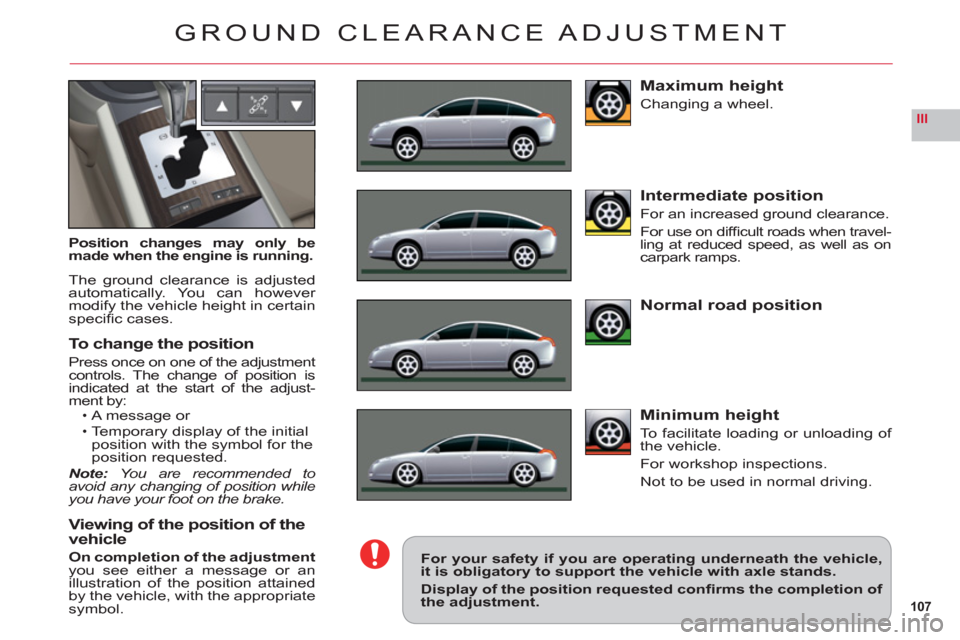
107
III
GROUND CLEARANCE ADJUSTMENT
Position changes may only bemade when the engine is running.
The ground clearance is adjusted
automatically. You can however modify the vehicle height in certainspecifi c cases.
To change the position
Press once on one of the adjustmentcontrols. The change of position is
indicated at the start of the adjust-ment by:A message or
Temporary display of the initialposition with the symbol for the position requested.
Note: You are recommended toavoid any changing of position whileyou have your foot on the brake.
Viewing of the position of the
vehicle
On completion of the adjustmentyou see either a message or an
illustration of the position attained
by the vehicle, with the appropriatesymbol.
•
•
Maximum height
Changing a wheel.
Intermediate position
For an increased ground clearance.
For use on diffi cult roads when travel-ling at reduced speed, as well as oncarpark ramps.
Normal road position
Minimum height
To facilitate loading or unloading of
the vehicle.
For workshop inspections.
Not to be used in normal drivin
g.
For your safety if you are operating underneath the vehicle,it is obligatory to support the vehicle with axle stands.
Display of the position requested confi rms the completion of the adjustment.
Page 110 of 216
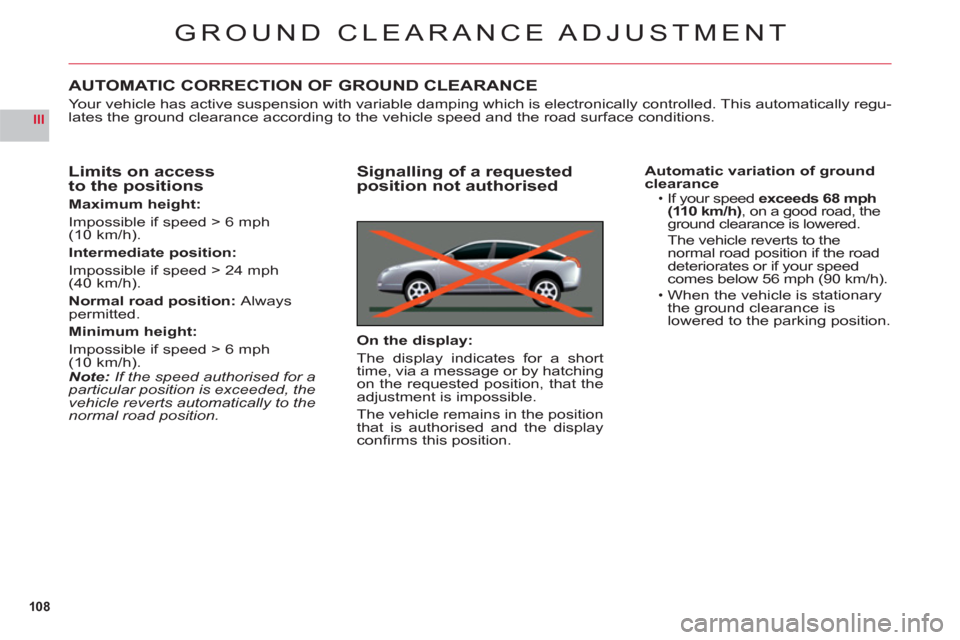
108
III
GROUND CLEARANCE ADJUSTMENT
AUTOMATIC CORRECTION OF GROUND CLEARANCE
Your vehicle has active suspension with variable damping which is electronically controlled. This automatically regu-lates the ground clearance according to the vehicle speed and the road surface conditions.
Limits on access
to the positions
Maximum height:
Impossible if speed > 6 mph(10 km/h).
Intermediate
position:
Impossible if speed > 24 mph(40 km/h).
Normal road position: Alwayspermitted.
Minimum height:
Impossible if speed > 6 mph(10 km/h).
Note:If the speed authorised for aparticular position is exceeded, the
vehicle reverts automatically to the
normal road position.
Signalling of a requestedposition not authorised
On the display:
The display indicates for a short
time, via a message or by hatching on the requested position, that the
adjustment is impossible.
The vehicle remains in the position
that is authorised and the display
confi rms this position.
Automatic variation of ground clearanceIf your speed exceeds 68 mph (110 km/h), on a good road, the ground clearance is lowered.The vehicle reverts to the normal road position if the road
deteriorates or if your speed comes below 56 mph (90 km/h).
When the vehicle is stationarythe ground clearance is lowered to the parking position.
•
•